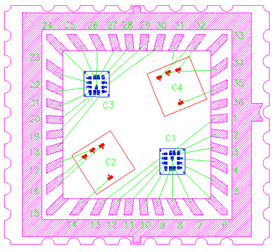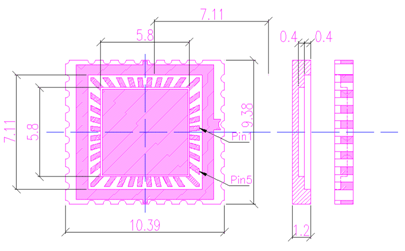Geant4-RADMON Vision document
The purpose of this document is to collect the specific requirements concerning the development of a Geant4 Advanced Example (named radiation_monitor) for the simulation and study of the effects of a chip carrier on silicon radiation monitoring devices used in the LHC environment.
Scope
The CERN RADMON group selects and catalogs semi-conductor chips for their application as radiation monitoring devices in the LHC environment. To proceed with their electrical tests, selection, quality assurance control, and to allow their following integration into any DAQ system a proper packaging must be designed.
It has been demonstrated that the use of inappropriate materials around the sensors can modify their response inducing error in the measurement, especially in the mixed hadrons field typical of the LHC experiments.
The geometrical description of the considered carriers must be developed using the Geant4 Simulation Toolkit in order to obtain a quantitative analysis of the effects caused by the packaging on the sensor.
The main objectives of the simulation study are:
- A quantitative analysis of the energy cut-off introduced by the packaging as a function of the particle type. The cut off can be defined in two ways: as the energy at which no particles (primaries and secondaries) comes to the sensor volume; and as the energy at which no primary particles comes to the sensor volume
- A quantitative analysis on how the materials and thicknesses affect the cut-off thresholds.
- A quantitative analysis of the spectrum of particles (primaries and secondaries) arriving on the dosimeter volume as a function of the incoming spectrum
- A quantitative analysis of the radiation environment of IRRAD 2 facility where several experimental data has been taken by the CERN RADMON group
References
Problem statement
Geometry description
The geometry of the packaging considered is consists of a stack of several layers made of different material, with different shape, and dimensions. A non-exhaustive list of layers consists of packaging layers, conductive layers and glue layers.
 |
 |
Along the external edges 36 pins are displaced. They are orthogonal to the
described layers structure and their length is only a fraction of the overall
packaging thickness, finally they partially bend on the bottom.
The figure shows a view of the packaging layout. Within the packaging up to 4 silicon sensors are glued and bonded. The component position and rotation could slightly change, while sensors-type and connections with the packaging pins are fixed.
In order to evaluate the effect, some packaging layers (such as glue layers and the top covering layer) could be omitted from the simulation. Moreover in the vision of a CERN-made production of carriers, some of the layers of the commercial packaging could be omitted. Even if there is a high variety of possible layers configuration, the external shape will be always the same in order to fit on the same electronics.
Some information of the commercial packaging are incomplete at this time: the vendor reports only a minimal thickness of the conductive layers; a material with properties similar to tungsten (W) could be present below the conductive layer; finally, the glue layers have a material composition not exactly known.
In the near future part of this missing information could be collected.
Sensors are represented by a bulk of silicon oxide with aluminum pads on the top of it. Sensors volume will be sensible in order to detect the particles that reach the device. Finally there must be the possibility to insert the sensor within other geometries (test beam geometries) for validation purposes.
Environment spectrum
The simulation will need to different primary generators according to the simulation purposes.
In the energy cut-off study, it must be used primary particles of the same type, same energy and uniform angular distribution. The particles types that must be generated are:
1. Neutrons (< 100 MeV)
2. Protons (< 20 GeV)
3. Pions (< 20 GeV)
4. Photons (< 10 MeV)
5. Electrons (< 10 MeV)
In the other studies, the same particles types must be generated according to tabulated spectra and in the right proportions between types. Tabulated spectra will be the ones of the IRRAD 2 setup, obtained from a Fluka simulation. The angular distribution will be still uniform.
Finally it must be provided the capability to reproduce a
beam, in order to provide a comparison against Fluka
simulation, and in order to validate data taken in test beams different from
IRRAD 2.
Physics choice and its validation
The Geant4 Toolkit provides a rich set of physics processes, covering an extended energy range. Geant4 physics is a domain still under active development and the validation of existing physics models against experimental data is the object of intense activity too.
The simulation must be able to select between different mutually exclusive physics models in order to investigate the most appropriate ones for the radiation environment of the packaging and sensor under study. For all the particle types and energy ranges involved, it must be identified the availability of appropriate electromagnetic and hadronic physics models and it must be verified the status of their validation.
During this process, it will be used the experimental measurements taken in the past years at the IRRAD2 facility of the naked sensor response. Moreover it is foreseen a test beam session in October in which packaged sensors could be tested within a well defined geometrical setup.
In order to provide the precision of our simulations, the comparison between experimental and simulated results plays an essential role. Besides, these validation studies will provide important information on the quality of the investigated Geant4 models. Finally this work could issue further recommendations for future Geant4 developments.
All the validation tests will be performed applying rigorous statistical techniques.
Geant4-RADMON simulation
Overview
The main requirements for the application are:
1. To model a variety of geometry and material configurations, corresponding to the different possible packaging setups and to the geometry of the experimental test beams.
2. To model a variety of primary event generators, in order to reproduce monochromatic environments, the spectra of the experimental test beams, and the spectra of the LHC environment
3.
To
study and validate the physics models relevant for this application, in order
to estimate the simulation precision
Constraints
The code should be developed according to ISO C++ standard
The analysis should not depend on any specific analysis
system. AIDA abstract interfaces only are used in the simulation application
System requirements
The application is developed and tested on the Geant4
supported platform Scientific Linux CERN 3 – gcc 3.2.3.
Porting to other Geant4 supported platforms should be easily feasible, since
the code will obeys to ISO C++ standards.
Documentation
Documentation will be released mainly through the web site of the Geant4-RADMON Simulation project.
Revision History
|
Version number |
Date |
Authors |
Note |
|
1.0 |
|
R. Capra |
Creation |
| 1.1 | 1 March 2006 | MGP | Reformatted |